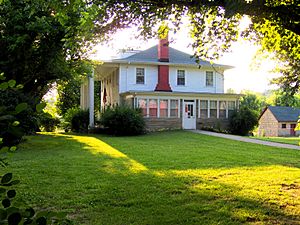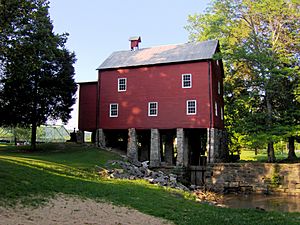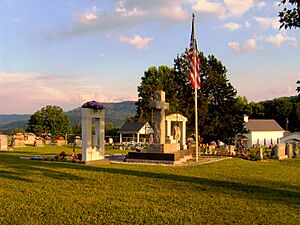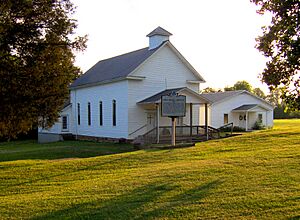Sgt. Alvin C. York State Historic Park facts for kids
Quick facts for kids Sgt. Alvin C. York State Historic Park |
|
|---|---|

Sgt. York house
|
|
| Type | Tennessee State Park |
| Location | Pall Mall, Tennessee |
| Created | 1967 |
| Open | Year round |
| Website | Sgt. Alvin C. York State Historic Park |
|
Alvin Cullom York Farm
|
|
|
U.S. Historic district
Contributing property |
|
| Nearest city | Pall Mall, Tennessee |
| Built | 1922 |
| Architect | Alvin C. York |
| Part of | Sergeant York Historic Area (ID73001763) |
| NRHP reference No. | 76001773 |
| Significant dates | |
| Added to NRHP | May 11, 1976 |
| Designated NHLD | May 11, 1976 |
| Designated CP | April 11, 1973 |
The Sgt. Alvin C. York State Historic Park is a special state park in Pall Mall, Tennessee. It's located along the Wolf River. This park was once the home and farm of Alvin C. York (1887–1964). He was a very famous soldier from World War I.
Alvin York lived in the Pall Mall area his whole life. The park includes his old farm, a gristmill (a mill for grinding grain), his two-story house, and his general store. You can also see the Wolf River Cemetery, where York and his family are buried. The Wolf River Methodist Church and the York Bible Institute are also part of the park.
Alvin York is known as one of America's most celebrated soldiers. In 1917, he was called to serve in World War I. He first tried to avoid fighting because of his religious beliefs. However, his request was not approved.
On October 8, 1918, during a battle in France, York and his group were ambushed. Many of his fellow soldiers were lost. York then bravely led the remaining soldiers in a counterattack. This action led to the capture of 132 German soldiers.
For his bravery, York received the Medal of Honor. He became a hero overnight. When he returned to the United States, many people offered him money for endorsements or movies. He usually said no, believing it was wrong to profit from war. The Nashville Rotary Club bought him his farm in Pall Mall, which he received in 1922. After York passed away in 1964, his wife gave the farm to the state of Tennessee to become a park.
Contents
Exploring the Park's Location
The community of Pall Mall is in a beautiful valley. The Wolf River flows through this valley. The river starts in the Cumberland Plateau to the east and moves west. York's farm is in a wide part of the valley, right by a bend in the river.
U.S. Route 127 (also called York Highway) is the main road here. It connects Pall Mall to Jamestown (about 10 miles south) and Byrdstown (about 15 miles northwest).
You can find York's house, the mill, and the post office along US-127. The Wolf River Cemetery, Wolf River Methodist Church, and the York Bible Institute are on Wolf River Loop. This road crosses US-127 about a mile south of York's house. A hiking trail, about 0.6 miles long, connects these two parts of the park.
A Look Back: Park History
The history of this area goes back a long time. Conrad "Old Coonrod" Pile, who was Alvin York's great-great-grandfather, came to the Wolf River area around 1800. He slowly bought more than a thousand acres of land in the valley. This land included what is now the Sgt. Alvin C. York State Historic Park.
In the 1820s, John Clemens, the father of the famous writer Mark Twain, lived here. He became a county court clerk with help from Conrad Pile. Clemens later moved to Missouri before his famous son was born.
York's grandfather, William Brooks, came to Pall Mall after the U.S. Civil War. He married Conrad Pile's granddaughter, Nancy.
By the early 1900s, the land that became the York farm belonged to the Wright family. In June 1919, after his heroic return from the war, Alvin York married Gracie Williams. Their wedding was a big event in Pall Mall, attended by Tennessee Governor A.H. Roberts.
The Rotary Club of Nashville wanted to buy the newlyweds a new home. This was one of the few gifts York accepted, but he insisted the home had to be in Pall Mall. In November 1919, the Rotary Club bought the 400-acre Wright farm. This farm had some of the best land in the Wolf River valley.
The club also paid for a new two-story house to be built. The Yorks moved into this house on Valentine's Day in 1922. The Rotary Club then paid off the farm and gave the land to York on May 18, 1922.
In 1925, York opened a general store across from his house. In 1943, he bought the two-story gristmill along the Wolf River. After York passed away, his wife, Gracie, sold the York Mill to the state of Tennessee in 1967. She later sold most of the York farm to the state for $180,000. She kept the rights to the house and a small piece of land until her death in 1984.
The York farm and mill became part of the U.S. National Register of Historic Places in 1973. The York farm was recognized as a National Historic Landmark on May 11, 1976.
Historic Buildings and Things to See
The park has several interesting historical buildings and attractions:
- The York House: This is a large, 2.5-story house built in 1922. It's designed in the Colonial Revival style. The house has chimneys at each end and a front porch with square columns. The first floor, which is now a museum, used to have a living room, sunroom, dining room, library, and kitchen. There were five bedrooms upstairs. You can also see a barn with two round stone silos nearby.
- The York Mill: This mill is located by a bend in the Wolf River, across the street from the York house. It was built around 1880. The millhouse is two stories tall and sits on pillars of stacked rocks. A milldam used to send water through a channel to turn a large turbine, which ground grain. The mill is no longer working, but it's still a cool place to see.
- The Wolf River Post Office: Alvin York first opened this building as a general store in 1925. It was used as a post office until the 1970s. It even had a small gristmill attached to its side.
- The Wolf River Methodist Church: This church is northeast of the York house, across the river. The Wolf River Methodist group started meeting here in 1840.
- Wolf River Cemetery: This cemetery is across the street from the Wolf River United Methodist Church. It was first called the Mt. Pleasant Burying Ground and began in the early 1800s. The oldest known burial here is from 1826. Conrad Pile and many of his family members, including Alvin York and his family, are buried here.
- The York Bible Institute: Alvin York built this institute in the 1940s. He used money he earned from the 1941 movie Sergeant York. The institute was open for a short time before it closed.
Near the York house, there used to be an M247 "Sergeant York" tank on display. This was a type of anti-aircraft tank named after Alvin York. A swing bridge crosses the Wolf River along the park's walking trail. It was built in 2000 by AmeriCorps*NCCC. This bridge connects the two main sections of the park. The park also has a small display of a "moonshine still" (two copper barrels) near the York Mill, showing how things were made in the past.
More to Learn







